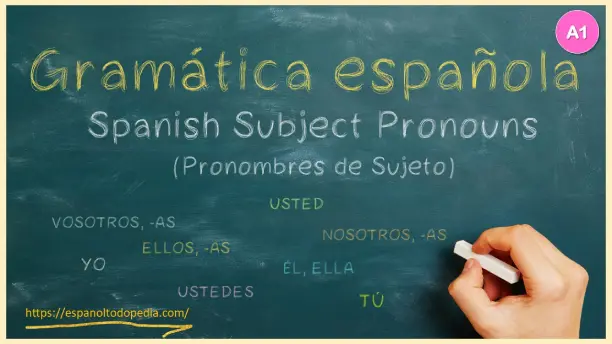A pronoun is a word used instead of a noun. There are different types of pronouns, but today, we will focus on Subject pronouns in Spanish (PRONOMBRES DE SUJETO EN ESPAÑOL). Subject pronouns identify who or what is acting as a verb. Below, you can see the Spanish subject pronouns with their equivalents in English.
English-Spanish Subject Pronouns Chart


Have you noticed, in the subject pronouns chart, that there are four ways to say «you» in Spanish?
Subject Pronouns in Spanish: How they work
In this video, Dr. Danny Evans explains how Subject Pronouns work in Spanish. Pronouns are crucial to learning Spanish, so grab a pen and pencil, and let’s get started!
10 tips about Spanish Subject pronouns
Ten things you must know about Subject Pronouns in Spanish:
1. Unlike «I» in English, yo isn’t written with a capital letter, except when it starts a sentence.
2. Tú (you) and él (he) have accents to distinguish them from tu (your) and el (the).
3. Notice that in Spanish, there are four words to say «you». Each uses a different verb ending:
- Tú: someone you call by the first name (informal)
- Usted: someone you don’t know well, someone older than you (formal). In writing, it’s usually abbreviated to Ud. or Vd., and the verb with it has the same ending as for el/ella( he/she).
- Vosotros/vosotras: more than one person in a familiar situation. It is mainly used in Spain.
- Ustedes: more than one person in a formal situation. In writing, it is usually abbreviated to Uds. or Vd. and the verb with it has the same ending as for ellos/ellas (they). In Latinamerica ustedes is used rather than vosotros/-as.
4. «We» can be the masculine nosotros or the feminine nosotras, depending on who’s talking. Similarly, who´s being addressed, the familiar plural you can be vosotros or vosotras. Masculine forms are used when these words relate to a mixed group of men and women. The same is true of ellos (they).
5. Spanish subject pronouns usually go before the verb, but they go after it in questions: ¿Pagan ellos? (Are they paying?).
6. When it is used as the subject and when they refer to things, you never use a subject pronoun in Spanish: Es un cachorro (It is a puppy). Son botellas de cava (They’re bottles of cava). There is a word for «it»: ello, but ello refers to a whole idea rather than a noun and is mainly used in formal written texts: No quiero hablar de ello (I don’t want to speak about it).
7. Subject pronouns are used much less than in English because the verb ending clearly shows who’s doing something. So, they tend to be primarily used to contrast, emphasize, or avoid ambiguity:
- Él trabaja en Buenos Aires, mientras que yo trabajo en Córdoba (He works in Buenos Aires while I work in Córdoba).
- Nosotros no podemos ir pero tú sí (We can’t go but you can).
- ¿Cómo se llama usted? (What’s your name?).
- ¿Cómo se llama él? (What’s his name?).
8. For even greater emphasis, you can add mismo/a/os/as:
- ¿Lo ha hecho ella misma? (Did she do it herself?).
- Usted mismo lo ha visto (You yourself saw him).
9. Subject pronouns are also used in phrases like these:
- Soy yo (It is me).
- ¿Quién, tú? (Who, you?).
- Nosotros también (Us too/So are/did we).
10. Don’t mistake subject pronouns with reflexive pronouns:
Yo me ducho con agua fría y ella se ducha con agua caliente (I shower myself with cold water, and she showers herself with hot water).
Practice Subject Pronouns in Spanish: Quizzes
Now, you can practice everything you have learned about Subject Pronouns in Spanish with our quizzes and word games. Just click on the link below to have free access to them.
More about Spanish Pronouns
A pronoun is a word we use instead of a noun when we do not need or want to name someone or something directly, such as it, you, none, etc.
There are several different types of pronouns. For instance, in this lesson, we have worked with the subject pronouns in Spanish, but let’s see other pronouns:
- Direct object pronouns are words such as «me», «him», «us» or «them», which are used instead of the noun to stand in for the person or thing most directly affected by the action expressed by the verb.
- Indirect object pronouns are used instead of nouns to show the person or thing an action is intended to benefit or harm.
- Reflexive pronouns are a type of object pronouns that form part of the Spanish Reflexive verbs like lavarse (meaning «to wash») or llamarse (meaning «to be called»).
- Possessive pronouns like «mine» or «yours», which show who someone or something belongs to.
- Indefinite pronouns like «someone» or «nothing», which refer to people or things in a general way without saying exactly who or what they are.
- Relative pronouns like «who», «which» or «what», which link to part of a sentence together.
- Interrogative pronouns like «who», «what» or «which». They are used in questions.
- Demonstrative pronouns like «this» or «those». They point out things or people out.
